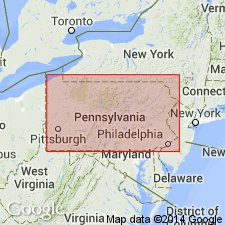
- Usage in publication:
-
- Buffalo Springs member
- Modifications:
-
- Named
- Dominant lithology:
-
- Limestone
- Dolomite
- AAPG geologic province:
-
- Appalachian basin
Summary:
Named the Buffalo Springs member of the Conococheague formation for Buffalo Springs, Lebanon Co., southeastern PA. Consists of dirty-white or pinkish-gray to medium-gray, crystalline limestone, commonly with laminae, alternating with yellowish-gray to light-olive-gray weathered dolomite and magnesian limestone; dolomite is fine to medium crystalline and commonly light gray on fresh surface; thin sandy limestone or silty limestone beds occur locally. Light-olive-gray weathering shaly limestone interbeds present in many outcrops. The white to pinkish-gray limestones commonly grade laterally into very light-gray limestone. Light-blue-gray limestone common near top of member. Estimated thickness more than 700 feet; base of member not exposed; partial type section is 247 feet thick. Underlies Snitz Creek member; unit is oldest exposed Cambrian limestone in quadrangle. The Buffalo Springs is of Late Cambrian age.
Source: GNU records (USGS DDS-6; Reston GNULEX).

- Usage in publication:
-
- Buffalo Springs formation
- Modifications:
-
- Revised
- AAPG geologic province:
-
- Appalachian basin
Summary:
Raised the Buffalo Springs to the Buffalo Springs formation of the Conococheague group on the PA State geologic map.
Source: GNU records (USGS DDS-6; Reston GNULEX).

- Usage in publication:
-
- Buffalo Springs Formation*
- Modifications:
-
- Overview
- AAPG geologic province:
-
- Appalachian basin
Summary:
The Buffalo Springs Formation of the Conococheague Group consists of white to very light pinkish-gray and medium- to medium-dark-gray limestone interbedded with very light pinkish-gray and yellowish-gray to medium-dark-gray dolomite. Limestone commonly contains laminae, patches, and stringers of dolomite. Dolomite is commonly argillaceous, silty, or sandy and contain sedimentary features such as cross laminae and ripple marks. Overlies Zooks Corner Formation and underlies Snitz Creek Formation.
Source: GNU records (USGS DDS-6; Reston GNULEX).

- Usage in publication:
-
- Buffalo Springs Formation
- Modifications:
-
- Overview
- AAPG geologic province:
-
- Appalachian basin
Summary:
The Buffalo Springs Formation in the Lebanon Valley sequence of the Great Valley consists of light-gray to pinkish-gray, finely to coarsely crystalline limestone and interbedded dolomite with numerous siliceous and clayey laminae and some thin sandy beds; stromatolitic limestone beds occur near top. Overlies Zooks Corner Formation and underlies the Snitz Creek Formation.
Source: GNU records (USGS DDS-6; Reston GNULEX).
For more information, please contact Nancy Stamm, Geologic Names Committee Secretary.
Asterisk (*) indicates published by U.S. Geological Survey authors.
"No current usage" (†) implies that a name has been abandoned or has fallen into disuse. Former usage and, if known, replacement name given in parentheses ( ).
Slash (/) indicates name conflicts with nomenclatural guidelines (CSN, 1933; ACSN, 1961, 1970; NACSN, 1983, 2005, 2021). May be explained within brackets ([ ]).

